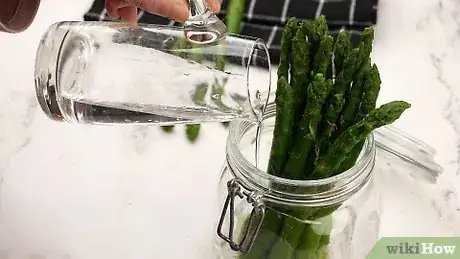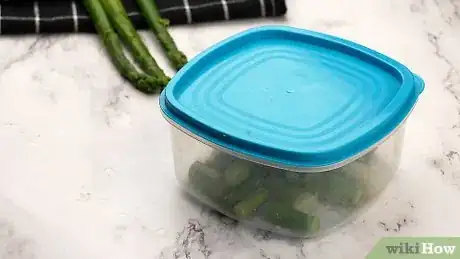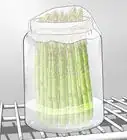wikiHow is a “wiki,” similar to Wikipedia, which means that many of our articles are co-written by multiple authors. To create this article, 17 people, some anonymous, worked to edit and improve it over time.
The wikiHow Culinary Team also followed the article's instructions and verified that they work.
This article has been viewed 243,477 times.
Learn more...
Asparagus will keep for a week or more in the refrigerator if you store it properly. Asparagus stalks are similar to flower stems: they need to be kept upright and moist to stay fresh. Learn how to store either fresh or cooked asparagus to help it last as long as possible.
Steps
Storing Fresh Asparagus
-
1Choose the freshest possible asparagus. Fresh asparagus should be bright green and firm from the tips all the way down the stalks. Check the bottom of the stalks: if they're tough and brown, that means the asparagus was not freshly cut.[1]
- Avoid asparagus with discoloration or brown spots.
- Don't choose asparagus that feels as though it's going limp.
-
2Leave the rubber band around the bunch. Asparagus usually come bunched and tied with a rubber band. The band makes it more convenient to store the asparagus upright and preserve freshness, so leave it in place until you're ready to cook your asparagus.[2]Advertisement
-
3Trim the ends if necessary. When you bring your asparagus home, you may need to trim half an inch or so from the ends of the stalks. Take a sharp knife and trim off the part that's a little tough and woody. Discard the cut ends.[3]
-
4Fill a bag or jar with an inch of water. A glass mason jar is usually just the right size for a bunch of asparagus. An empty jelly jar or pickle jar also works well. If you're trying to save space in your refrigerator, go with a sturdy plastic storage bag. Fill your storage container with an inch or so of water, enough to submerge the ends of the asparagus.[4]
- There's no need to fill the container all the way to the top; you just enough water to keep the asparagus moist.
- Another convenient method is to dampen a paper towel and wrap it around the cut ends of the asparagus. You'll need to change the paper towel every few days as it dries out.
-
5Store the asparagus upright in the container. Storing the asparagus upright allows it to soak up the water from the container, keeping the stalks fresh and firm. If you're using a storage bag, rubber band the top of the bag around the asparagus so you can store it upright on the refrigerator door without spilling water.[5]
-
6Cover with a plastic bag. Use a loose plastic bag (the type used for produce at the grocery store) and drape it over the asparagus tips and jar. This will keep the asparagus tasting fresh; without the bag, the stalks will take on the flavor of whatever else you're keeping in your refrigerator.[6]
-
7Change the water when it gets cloudy. Check the water every few days and switch it out when it's no longer clear, just as you would for cut flowers. You should change the water no more than once or twice before consuming the asparagus within a week or so.[7]
Freezing Asparagus
-
1Choose fresh, thick asparagus spears. Spears thicker than a pen will hold up better to freezing than thinner asparagus. Choose fresh, in-season asparagus that has not gone limp or woody. Avoid asparagus that is brown or discolored; it won't taste good after freezing.[8]
-
2Chop off the woody ends. Chop about one inch from the ends of the asparagus. The chewy texture of the ends is unpleasant, especially after freezing, so make sure you get rid of the entire dry or woody part.
-
3Boil water and prepare an ice bath. In order to retain its flavor, asparagus should be blanched before freezing. This is the process of boiling the asparagus for about 30 seconds and removing it from heat before it loses its crunch. The asparagus is plunged into ice water to stop it from cooking. Boil a large pot of water and prepare a large bowl of ice water.[9]
-
4Chop the asparagus into one-inch pieces. In order for the asparagus to blanch evenly, it's best to chop it into smaller pieces. If you'd prefer to leave the stalks intact, that's fine, but the flavor may be compromised.
-
5Boil the asparagus for one minute. If your spears are extra-thick, boil them for longer; if they're thin, boil them for just thirty seconds. Monitor the asparagus carefully so you don't end up overcooking it.
-
6Transfer the asparagus to the ice bath. Use a slotted spoon to immediately transfer it to the ice bath so it can cool down and stop cooking. Leave it in the ice bath for the same amount of time you boiled it, then transfer it to a colander to let it drain and dry.
-
7Flash freeze the asparagus. Lay out the pieces on a baking sheet, cover with plastic wrap, and place the sheet in the freezer. Freeze the asparagus for about one hour, until each piece is slightly ice. Flash freezing the asparagus before longer-term storage will keep the pieces from freezing together into a solid mass.[10]
-
8Transfer the asparagus to a freezer-safe container. Put the frozen pieces into a freezer bag or a plastic freezer container. Pack it as tightly as possible in order to remove most of the air. Label the container with the date.
- Frozen asparagus will keep for up to a year in properly cold conditions.
- There's no need to thaw asparagus before cooking; just add it to soups and other dishes frozen.
Storing Cooked Asparagus
-
1Don't overcook the asparagus. Overcooked asparagus becomes mushy, and if you try to reheat it after storing it will be pretty much inedible. If you want to store your cooked asparagus, make sure it still has some bite left after cooking.
- Blanching or steaming asparagus is a great way to bring out its flavor while retaining its crisp texture.
- Sauteed and roasted asparagus also hold up well to storage if they aren't overcooked.
- Boiling asparagus often results in a mushy texture, so avoid this method.
-
2Store the asparagus in an airtight container. Cooked asparagus will last the longest if you store it in a container with as little air as possible. A plastic or glass food storage container with a tight-fitting lid is best.
-
3Keep the asparagus refrigerated for five to seven days, maximum. Cooked asparagus is best within a few days of storing it. After that, it begins to lose its bright taste and firm texture.[11]
Community Q&A
-
QuestionHow can I store asparagus so it does not get damp and rot?
 Community AnswerI wrap a dry paper towel around the tips of the asparagus and secure it with one of the rubber-bands that come with the asparagus. I put the stems in a quart size storage bag with the paper towel covered tips tips sticking out of the top. I have had a bunch of asparagus stored this way in the refrigerator for over a week now and it is still not rotting. I plan on trying this method in combination with the other storage methods listed at this site (i.e. putting the tips in a mason jar with 1" water).
Community AnswerI wrap a dry paper towel around the tips of the asparagus and secure it with one of the rubber-bands that come with the asparagus. I put the stems in a quart size storage bag with the paper towel covered tips tips sticking out of the top. I have had a bunch of asparagus stored this way in the refrigerator for over a week now and it is still not rotting. I plan on trying this method in combination with the other storage methods listed at this site (i.e. putting the tips in a mason jar with 1" water). -
QuestionCan I cook asparagus in a microwave?
 Community AnswerYes, you can cook asparagus in the microwave, but it's not the best choice.
Community AnswerYes, you can cook asparagus in the microwave, but it's not the best choice.
References
- ↑ http://www.realsimple.com/food-recipes/cooking-tips-techniques/asparagus-tips
- ↑ https://www.thekitchn.com/the-best-way-to-store-asparagus-203442
- ↑ https://www.realsimple.com/food-recipes/cooking-tips-techniques/asparagus-tips
- ↑ https://www.thekitchn.com/the-best-way-to-store-asparagus-203442
- ↑ https://www.thekitchn.com/the-best-way-to-store-asparagus-203442
- ↑ https://www.thekitchn.com/the-best-way-to-store-asparagus-203442
- ↑ https://www.thekitchn.com/the-best-way-to-store-asparagus-203442
- ↑ https://www.localharvest.org/blog/50346/entry/freezing_asparagus
- ↑ https://www.localharvest.org/blog/50346/entry/freezing_asparagus
About This Article
To store fresh asparagus, be sure to select asparagus that is bright green and doesn't have any brown spots. Leave the rubber band on the bunch of asparagus and trim off the ends if they look brown or woody. Then, fill a jar with 1 inch of water and put the asparagus stem-side down in the water. Cover the top with a plastic bag and change the water every few days, or when it becomes cloudy. It should last about a week in your fridge.































































